

Scrappy Circuits. The best dollar you can spend on a child’s STEAM education is to take them to the dollar store, buy an electronic item, and then take it apart. Learning how a handheld fan, LED light, remote control, or headphones work will help show how wind turbines, traffic lights, speakers, keyboards, and other modern devices function. The next step is to take apart a dollar store item and make it better — combine two items, replace a switch, create something new and unique. Scrappy Circuits is the perfect way to get started. I first developed Scrappy Circuits with Chris Connors and Eva Luna while working at Xraise, an education outreach program at Cornell University. What began as an exploration of DIY switches ended later as a self-made invention system sourced from a fifty-cent LED tea light.
Take Apart a Tea Light Open the battery compartment, remove the 3V coin cell battery, and pry the base/LED holder apart from the outer cylinder body. Battery Brick The power source for your Scrappy Circuits. PHYS_Equipotential Lines and Electric Fields.pdf. Motor Effect Spring2014 v1. Stripped Down Motor Spring2014 v1. Ion Engines. Ion Engines are the most exciting new rocket propulsion system since the Chinese invented the rocket about a thousand years ago.

Most rocket engines use chemical reactions for power. They combine various gases and liquids to form chemical explosions which push the rocket through space. Chemical rocket engines tend to be powerful but have a short lifetime. Ion Engines use electric fields instead of chemical reactions. Ion Engines tend to be much less powerful, but they are so efficient, they can last for years before running out of fuel. These activities should help you understand how Ion Engines work. Before you can understand the entire Ion Engine, you need to understand some basics about electric charges. Play the first three activities to learn about electric charges. From Magnets and Coils to Woofers and Tweeters Spring2014 v1. Science and Technology of WWII. So What is This About?
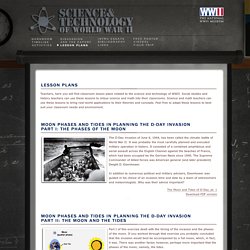
Teachers, here you will find classroom lesson plans related to the science and technology of WWII. Social studies and history teachers can use these lessons to imbue science and math into their classrooms. Science and math teachers can use these lessons to bring real-world applications to their theories and concepts. Feel free to adapt these lessons to best suit your classroom needs and environment. The D-Day invasion of June 6, 1944, has been called the climatic battle of World War II. Sheets - create and edit spreadsheets online, for free. One account.
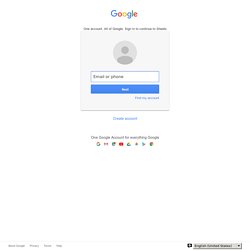
All of Google. Sign in to continue to Sheets Find my account. Google Docs - create and edit documents online, for free. Google Docs - create and edit documents online, for free. Determining the Mass of a Car. SciencePorn - #diplymix. Conservation of Momentum. Collisions. Engineering Balloon Racers. Mass and Momentum. 07 Investigations - Heck's Physics.
04 Investigations - Articles - Power Points - Tests - Heck's Physics. 07 Manual Forces and Motion - Heck's Physics. Silly Putty, Thinking Putty. Snap Attack Magnetic Game. NILS FERBER. 4 amazing tricks with batteries.□... - Smart is the New Sexy. Free K - 12 Common Core Lesson Plans and Ideas.
Free K - 12 Common Core Lesson Plans and Ideas. 09 Magnetism - Heck's Physics. Measuring the Strength of a Magnet. Bigger magnets aren’t always “stronger”.

But how do you make a comparison between different magnets? One way is to determine the magnetic dipole moment of the magnet. Magnetic Dipole Moment Maybe you aren’t quite sure about dipoles, but let me go ahead and say that a bar magnet isn’t actually a dipole. Ok, now for an actual dipole. Notice that I have correctly drawn this dipole by putting the positive charge as a red object and the negative as blue.
Now suppose you look at a bar magnet. But how do you quantify this in some way? For two electric charges, the magnitude of the field along the axis can be found as: Chapter 4: The Periodic Table & Bonding. Show a picture of a pencil point and how the carbon atoms look at the molecular level.
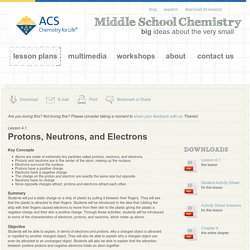
Project the image Pencil Zoom. Students should be familiar with the parts of the atom from Chapter 3 but reviewing the main points is probably a good idea. Ask students questions such as the following: What are the three different tiny particles that make up an atom? Protons, neutrons, and electrons. Electromagnetism Experiments. Electric current flowing through a wire creates a magnetic field that attracts ferromagnetic objects, such as iron or steel.

This is the principle behind electromagnets and magnetic levitation trains. It allows cranes to pick up whole cars in the junkyard and makes your doorbell ring. Electricity. The Good, the Bad and the Electromagnet. Summary Using plastic straws, wire, batteries and iron nails, student teams build and test two versions of electromagnets—one with and one without an iron nail at its core.
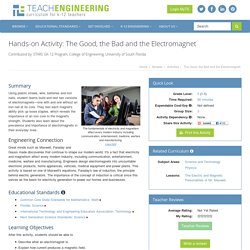
They test each magnet's ability pick up loose staples, which reveals the importance of an iron core to the magnet's strength. Students also learn about the prevalence and importance of electromagnets in their everyday lives. Engineering Connection Great minds such as Maxwell, Faraday and Gauss made discoveries that continue to shape our modern world. Educational Standards Each TeachEngineering lesson or activity is correlated to one or more K-12 science, technology, engineering or math (STEM) educational standards. All 100,000+ K-12 STEM standards covered in TeachEngineering are collected, maintained and packaged by the Achievement Standard Network (ASN), a project of JES & Co. Static Cling. Summary This hands-on activity explores the concept of static electricity.

Students attract an O-shaped piece of cereal to a charged comb and watch the cereal jump away when it touches the comb. Students also observe Styrofoam pellets pulling towards a charged comb, then leaping back to the table. Engineering Connection Engineers consider static electricity when designing, manufacturing and packaging electronic circuit boards. Educational Standards Each TeachEngineering lesson or activity is correlated to one or more K-12 science, technology, engineering or math (STEM) educational standards. All 100,000+ K-12 STEM standards covered in TeachEngineering are collected, maintained and packaged by the Achievement Standard Network (ASN), a project of JES & Co. In the ASN, standards are hierarchically structured: first by source; e.g., by state; within source by type; e.g., science or mathematics; within type by subtype, then by grade, etc. Whose Field Line Is It, Anyway? Summary Students teams each use a bar magnet, sheet of paper and iron shavings to reveal the field lines as they travel around a magnet.

They repeat the activity with an electromagnet made by wrapping thin wire around a nail and connecting either wire end to a battery. They see that the current flowing through a wire produces a magnetic field around the wire and that this magnetic field induced by electricity is no different than that produced by a bar magnet. The experience helps to solidify the idea that electricity and magnetism are deeply interrelated. The Electric and Magnetic Personalities of Mr. Maxwell. Summary.
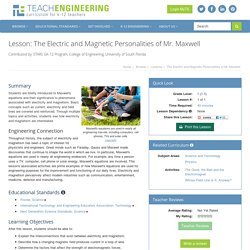
Circles of Magnetism IV. Curie Point. Circles of Magnetism I. Motor Effect. Piezoelectric One-Way Remote. Jitterbug. Simple Portable Conductivity Meter. Shake Table. Stretch the Chain and See the Light. Kosher Dill Current: Make Your Own Battery! Glowing Pickle. Short Circuit. Polar Opposites. Electroscope. Magnetic Suction. Stripped-down Motor. Simple Spinner. Cake by Conduction. Magnetic Pendulums. Penny Battery. Hand Battery.
Electrostatic Water Attraction. Eddy Currents. Holding Charge. Make a Speaker: A Coil, a Magnet, and Thou.